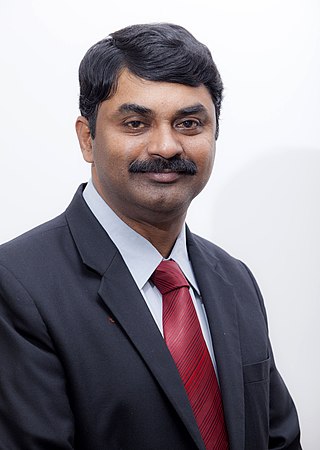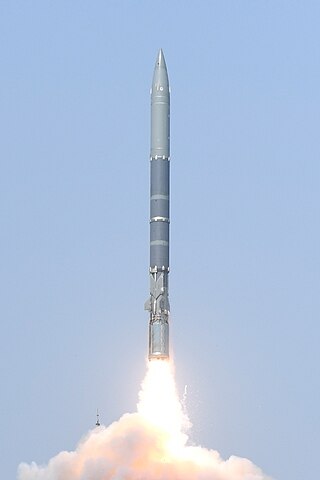The Maitri missile (Friendship) [1] project was a cancelled proposal for a next-generation quick-reaction surface-to-air missile (QRSAM) with a lethal near-hundred per cent kill probability (according to manufacturer's claim) planned for development by India's Defence Research and Development Organisation. It is a short-range (strike range varies from 25–30 km) surface-to-air defense missile system. [2]
The proposal was shelved and superseded by the QRSAM and VL-SRSAM missiles for the use of the Indian Army and Indian Navy respectively.
The Maitri missile should not be confused with the similar Indian Army Low-Level Quick Reaction Missile system (LLQRM) requirement. The missile will fill the gap created by the Indian government's decision to wind up development of the Trishul point defense missile system. It is believed to be a blend of the French Mica and DRDO Trishul. Maitri will build on the work done by DRDO while developing the Trishul missile, using technology transfer from MBDA to fill the technological gaps that led to the failure of the Trishul project.
On 15 July 2009, The Telegraph reported that the project was scrapped. [3] But later, on June 4, 2010 Indian Express reported that, "After moving ahead with similar projects with Russia and Israel, India is set to finalise a missile co-development project with France to manufacture a new range of Short Range Surface to Air Missiles (SRSAM) for the armed forces." From 2007-2010, MBDA and DRDO finalised the design and performance parameters of the missile to suit the needs of the Indian armed forces. Besides providing the Indian armed forces with a modern air defence missile, the project will also add a new capability with France, which does not have a similar missile in production. [4]
The Maitri missile project involved a technological collaboration between MBDA, India’s Defence Research and Development Organisation (DRDO) and defence public sector unit Bharat Dynamics Limited. Defence Research and Development Laboratory (DRDL), a premier missile laboratory of DRDO, will act as the main design centre in India. The project, with a budget of US$500 million was said to have been signed in May 2007. [5]
On 14 February 2013, India and France concluded negotiations on the Short Range Surface to Air Missile nearly worth of $6 billion during the talks between French President Francois Hollande and Prime Minister Manmohan Singh. [6]
On 30 March 2015, it was reported that the project was revived specially by the request of Indian Navy for a point air defence system after stating that Akash missile defence system is not suitable for Indian warships defence. The DRDO with MBDA is planning to develop 9 short-range surface-to-air missile system (SRSAM) with 40 missiles each for Indian Navy. [7] Development of the missile is expected to be completed within three years of the project go-ahead, when initial testing will commence.
As of 2020, The project was expected to be cancelled as DRDO has instead taken up the development of an alternative missile known as VL-SRSAM derived from the Astra Mk1 air-to-air missile for use by the Indian Navy and QRSAM for the Indian Army. [8]
The principal contribution of MBDA will be in providing be the active homing-head, thrust vector control, terminal guidance system and composites for a modified propulsion system for the missile, while the software, command-and-control system, the launchers and system integration work would be carried out by the DRDL.
MBDA has agreed to transfer all sensitive technology such as the seeker and thrust vector control system to India, allowing India to manufacture the Maitri missile locally as well as support them. [9]
The Electronics & Radar Development Establishment (LRDE), Bangalore, would develop two indigenous radars for the Maitri project. These would be new-generation variants of Central Acquisition Radar (3D-CAR), with the ability to track 150 targets simultaneously at a distance of 200 kilometers. The naval variant would be called the Revati and the air force version would be called Rohini.
Two variants of the missile were planned:
There are two variants which are as below:

The MICA, abbreviated from its full name Missile d'Interception, de Combat et d'Auto-défense or alternate translation is a French anti-air multi-target, all weather, fire-and-forget short and medium-range missile system manufactured by MBDA France. It is intended for use both by air platforms as individual missiles as well as ground units and ships, which can be equipped with the rapid fire MICA Vertical Launch System. It is fitted with a thrust vector control (TVC) system. It was developed from 1982 onward by Matra. The first trials occurred in 1991, and the missile was commissioned in 1996 to equip the Rafale and Mirage 2000. It is a replacement for both the Super 530 in the interception role and the Magic II in the dogfighting role.

The Integrated Guided Missile Development Programme (IGMDP) was an Indian Ministry of Defence programme for the research and development of the comprehensive range of missiles. The programme was managed by the Defence Research and Development Organisation (DRDO) and Ordnance Factories Board in partnership with other Indian government political organisations. The project started in 1982–83 under the leadership of Abdul Kalam who oversaw its ending in 2008 after these strategic missiles were successfully developed.

Akash is a medium-range mobile surface-to-air missile (SAM) system developed by the Defence Research and Development Organisation (DRDO) and produced by Bharat Dynamics Limited (BDL). Surveillance and Fire control radar, tactical control and command center and missile launcher are developed by Bharat Electronics (BEL), Tata Power Strategic Engineering Division and Larsen & Toubro. The Akash missile system can target aircraft up to 45 km (28 mi) away. It has the capability to neutralise aerial targets like fighter jets, cruise missiles and air-to-surface missiles. It is in operational service with the Indian Army and the Indian Air Force.
Trishul is a low-level quick-reaction short range surface-to-air missile developed in India by Defence Research and Development Organisation (DRDO) as part of the Integrated Guided Missile Development Programme (IGMDP). It can also be used as an anti-sea skimmer from naval ship against low flying missile, attack helicopter and aircraft.

Astra is an Indian family of all weather beyond-visual-range air-to-air missile, developed by the Defence Research and Development Organisation. Different missiles of this family are capable of engaging targets at varying distances of 500 m (0.31 mi) up to 340 km (210 mi). Astra Mk-1 has been integrated with Indian Air Force's Sukhoi Su-30MKI and will be integrated with Dassault Mirage 2000, HAL Tejas and Mikoyan MiG-29 in the future. Limited series production of Astra Mk-1 missiles began in 2017.
Electronics and Radar Development Establishment (LRDE) is a laboratory of the Defence Research & Development Organisation (DRDO), India. Located in C.V. Raman Nagar, Bengaluru, Karnataka, its primary function is research and development of radars and related technologies. It was founded by S. P. Chakravarti, the father of Electronics and Telecommunication engineering in India, who also founded DLRL and DRDL.

The central acquisition radar (3D-CAR) is a 3D radar developed by DRDO for use with Akash SAM capable of tracking 150 targets.

Barak 8, also known as LR-SAM or MR-SAM, is an Indo-Israeli jointly developed surface-to-air missile (SAM) system, designed to defend against any type of airborne threat including aircraft, helicopters, anti-ship missiles, and UAVs as well as ballistic missiles, cruise missiles and combat jets. Both maritime and land-based variants of the system exist.
India has studied, produced and used various strategic and tactical missile systems since its independence. Decades long projects have realised development of all types of missile systems including ballistic, cruise, anti-ship, air-defence, air-to-air and anti-missile systems. India is one of seven countries in the world with intercontinental ballistic missiles (ICBMs) and one of four countries with anti-ballistic missile systems. Since 2016, India has been a member of Missile Technology Control Regime (MTCR).
Ordnance Factory Medak (OFMK), previously called Ordnance Factory Project Medak (OFPM) while in its development stage, is a factory owned by Armoured Vehicles Nigam Limited, a company that manufactures armoured vehicles and was one of the 41 Indian ordnance factories under the erstwhile Ordnance Factories Board of the Ministry of Defence, controlled by Government of India.

G. Satheesh Reddy is the Scientific Adviser to Raksha Mantri, leading India's indigenous development of defence systems and technologies. He has worked on the development of missiles, fighter aircraft, unmanned aerial defence systems, and radar systems.

The Rudram is a series of air-to-surface ground attack and anti-radiation missiles in development by the Defence Research and Development Organisation of India. It can be launched from a range of altitudes with large standoff distance for destroying enemy surveillance radars, communication stations and bunkers.

Quick Reaction Surface-to-Air Missile (QRSAM) is a missile developed by the Defence Research and Development Organisation (DRDO), Bharat Electronics Limited and Bharat Dynamics Limited for the Indian Army, meant for protecting moving armoured columns from aerial attacks.

Akash - New generation abbreviated as Akash-NG is a mid-ranged mobile surface-to-air missile defense system developed by the Defence Research and Development Organisation (DRDO) and produced by Bharat Dynamics Limited (BDL) and Bharat Electronics (BEL).

The Vertical Launch – Short Range Surface to Air Missile, or VL-SRSAM is a quick reaction surface-to-air missile developed by the Indian Defence Research and Development Organisation (DRDO). During mid-course flight, the missile uses fibre-optic gyroscope based inertial guidance mechanism while in terminal phase uses active radar homing. With lock on before launch (LOBL) and lock on after launch (LOAL) capability, the missile receives mid-course update via datalink. VL-SRSAM intended to replace older Barak 1 surface to air missile system onboard Indian Navy warships. It will also be used as short range air defence system for Indian Air Force.

SMART is a canister-based, long-range supersonic anti-submarine missile developed by the Defence Research and Development Organisation (DRDO) for the Indian Navy.
This article consists of projects of the Defence Research and Development Organisation.

The Very Short Range Air Defence System, or VSHORADS, is a fourth generation, man-portable air-defense system (MANPADS) developed by Research Centre Imarat (RCI),a research lab under Defence Research and Development Organisation (DRDO), located in Hyderabad. Multiple DRDO laboratories along with Indian Industry Partners are participating in the project. It is designed for anti-aircraft warfare and neutralising low altitude aerial threats at short ranges.